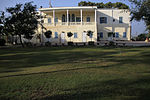Nitzanim Nature Reserve

The Nitzanim Sand Dune Nature Reserve is a 21,600 dunam area within the Nitzanim Sands area between Ashdod and Ashkelon on the Southern Coastal Plain of the Israeli Mediterranean Sea coast.It was declared as a public area in early 1980s by the Society for the Protection of Nature in Israel and designated as a nature reserve on June 2, 2005.The Reserve includes a small settlement of Nitzan located in place of the Nitzanim kibbutz, which was resettled some 3-4 km to the south. The reserve is split in two parts by the Nahal Evtah (Evtach, Avtah) (Hebrew: נחל אבטח) wadi (Wadi el Ibtah) which leads to the Nitzanim Beach by the sea. The beach is a public area not part of the Reserve. The area south of the stream is designated for the IDF recruit training base Batar Nitzanim (Camp Yehoshua) and is closed to public. The northern part is open to public all year round free of charge.In 2005, during the Israeli disengagement from Gaza there was a controversial plan to resettle some Israeli settlers from Gaza Strip to the Nitzanim Dunes area.
Excerpt from the Wikipedia article Nitzanim Nature Reserve (License: CC BY-SA 3.0, Authors, Images).Nitzanim Nature Reserve
3631, Hof Ashkelon Regional Council
Geographical coordinates (GPS) Address Nearby Places Show on map
Geographical coordinates (GPS)
| Latitude | Longitude |
|---|---|
| N 31.736944444444 ° | E 34.614722222222 ° |
Address
3631
7928900 Hof Ashkelon Regional Council
South District, Israel
Open on Google Maps











